Corporal punishment in the Navy
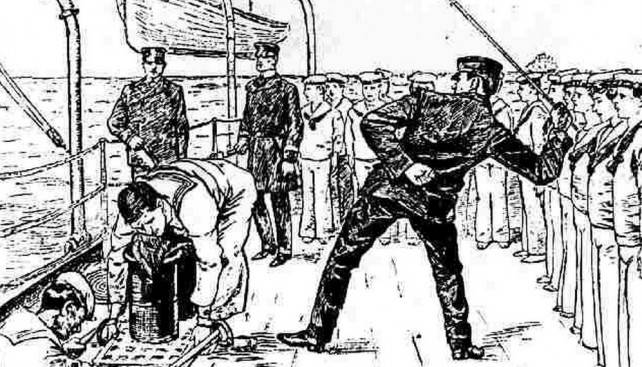
The punishment system for negligence or committed misconduct in the sailing era was very sophisticated. For example, the officer always had a “nine-tailed cat” at hand — a special whip with nine ends that left non-healing scars on its back.
There were quite complex forms of punishment - pulling under the keel, hanging on the mast ... For serious crimes - rebellion, murder, insubordination or resisting an officer - a loop was waiting. It used to happen that several dead people hung on a sailboat entering the port at once. Well, and you can not even talk about constantly fists fired. Appropriation was an integral part of the relationship within the crew of any sailing vessel ...
The concept of "stick discipline" in relation to the military the fleet Sailing era, perhaps, will be too soft. As early as the beginning of the 1861th century, on the ships of all the great sea powers, the lower ranks were subjected to punishments, which were “the fruit of the most barbaric inventions of the human imagination to torture the unfortunate” - such a definition was given to them in XNUMX by the author of the journal “Marine Collection”. However, over the past several centuries, sophisticated executions of sailors in the Navy were considered the norm.
The "mistress of the seas" Great Britain was the most successful in this direction. Manning the numerous Royal Navy was not so easy, and a large part of the crews of the British ships were violent guys recruited in port kabaks, shelters and even prisons. If we add to this the severity of the maritime service, the closeness in the cockpit, poor nutrition, illness, then the irritability of the sailors and their nervous breakdowns, which often led to disobedience, fights and stabbing, become understandable. The officers were convinced that it was impossible to maintain order on a vessel with such personnel without a system of severe punitive measures. And these measures were applied with an unprecedented scale. And for greater effect, the process of punishing the guilty was furnished as a kind of colorful show.
The most common executions in the British fleet were pulling under the keel of the ship, or keelhauling, ducking, running the gauntlet, the so-called skylarking. Well and, of course, the mentioned “nine-tailed cat” (cat o'nine tails), which left an unkind memory of many generations of sailors.
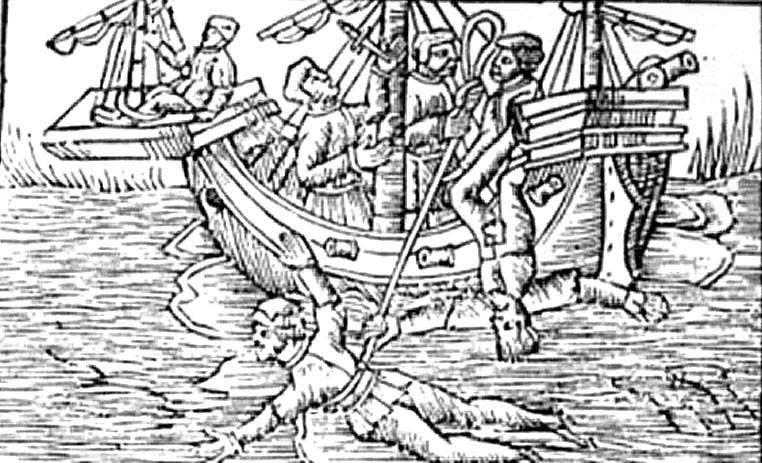
English engraving of the Tudor era also depicts pulling under the keel
Sometimes they write about pulling under the keel, as if the British borrowed it from the Dutch in the 17th century. But in reality, this ritual of punishment is much older: it is mentioned in the Hansa decree of the XIII century, and in one of the ancient vases there is an image of a certain action very similar to kelevanie. The essence of the execution was that a rope was wound up under the keel of the vessel, the ends of which were attached to the blocks on the legs of the lower yoke. The guilty were tied to a rope and dragged under the keel from one side to the other. If he did not choke, then he was given some time to catch his breath, and then "bathed" again, stretching in the opposite direction. Often, the penalty box was dragged out of the water to the bloodstream, as it stripped the skin of the sharp edges of the shells, which covered the underwater part of the hull in abundance. Well, if the rope for some reason stuck, the inevitable death was waiting for the condemned man.
Diving into the sea also constituted a forced “bathing” of the guilty. He was put astride a log, tied and fastened to the legs of the load. Then the log was lifted on the block to the point of ray, thrown from the height into the water, and then the rope was slowly selected, lifting the penalty box again to the point of ray. It is pertinent to note that such a punishment could have been much simpler, but a complicated procedure with throwing a log significantly increases the entertainment (and, accordingly, the educational role) of execution.
The sailors took over the run through the structure from their army colleagues. The crew of the ship lined up on the deck in two rows, between which they let the convict stripped naked to the waist. Ahead of and behind him were non-commissioned officers armed with sabers. Each crew member was given a woven rope with knots, with which he had to hit the guilty one time.
In Russia, a similar punishment existed in the army, only soldiers were supplied not with ropes, but with gauntlets.
“Contemplation of the sky” - under such a romantic name the punishment is hidden when a man who was at fault is tied up and pulled to the top of the mast in a special way, leaving him hanging there with his arms and legs open for several hours. The English call it hanging “like an eagle with spread wings” (like a spread eagle).
Punishing a guilty slave on a slave ship
But the most cruel punitive tool used at the same time for punishment is the “nine-tailed cat” - a special whip consisting of a wooden handle one foot long and nine straps or hemp ropes, at the ends of which one or two knots are tied. Whipping with this whip came to the lower ranks for any wrongdoing - for the slightest breach of discipline, for lack of zeal in performing deck works, for playing illegal gambling ... There is a case when a sailor of the English gunner received 60 blows with a “cat” for spitting on the deck .
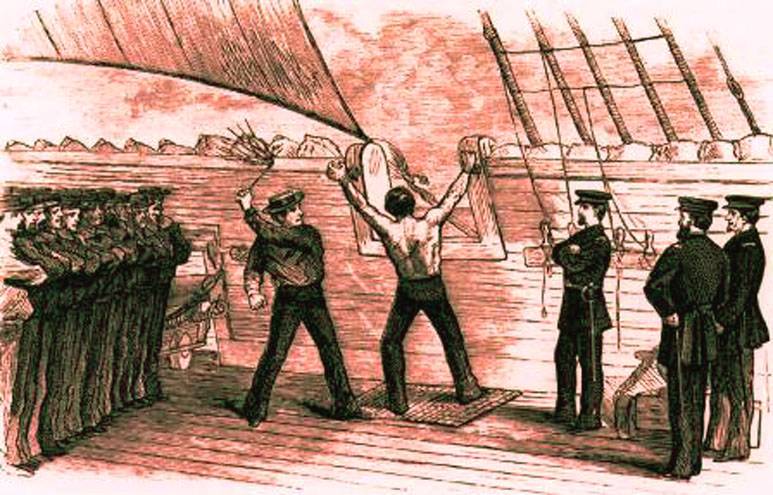
The procedure for the execution of punishment was as follows. The crew lined up on deck, and a naked sailor, stripped to the waist, was escorted under escort to a whipping site, usually to the mainmast. The captain expounded the essence of the committed offense and announced the verdict. The feet of the victim were fixed on a wooden frame or payole, raised hands tied up with a rope, which was then passed through the block. Penalty stretched like a string, and the executioner who played the role of executioner proceeded to scourging. To increase the suffering of the unfortunate, the "nine-tailed cat" was soaked in salt water or urine. The officers closely watched the whipping process: if the blows seemed to them not strong enough, the boatswain was threatened with a similar punishment. Therefore, the latter, as a rule, tried his best.

The minimum "portion" was ten hits, but for serious misconduct the commander could appoint seventy or even a hundred. Not everyone could endure such an execution - the back of the unfortunate turned into a bloody mess, from which rags of skin hung. Cases of the nine-tail cat flogging before death were not uncommon. Therefore, in the 1844, the British Admiralty issued special rules prohibiting sailors from inflicting more than 48 strikes.
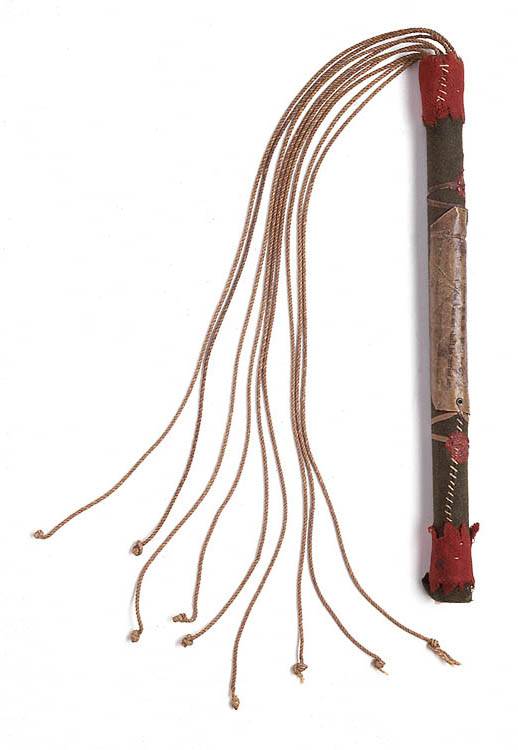
Bad memory "nine tail cat" - cat o'nine tails. The sailors called the nodes at the ends of its tails “bloody” - bloody knots.
By the middle of the XIX century, the attitude towards the lower ranks on the part of the command becomes more humane. Finally, the practice of pulling under the keel and immersion in water stops; the penalties for minor offenses are mitigated.
In the British fleet, sanctions such as shifting from 1 class to 2, sanctions, imprisonment, vacation time, salary or grog deprivation, stripping of good behavior are being imposed. It is curious that in addition to the deprivation of the daily cup (no grog), such punishments as the dilution of grog with water and the prohibition of smoking tobacco for half the time specified for eating are provided for. In addition, the commander of the ship can force the offending sailor for half the lunchtime and also stand under the watchman’s watch for two hours in the evening or do emergency and dirty work at this time. However, it is indicated that “the punishments, which are determined in the penalty lists, are suspended on Sundays”.
Nevertheless, corporal punishment in the British fleet persisted in the second half of the XIX century. Here are the numbers of official statistics on the use of the nine-tailed cat:
“In 1854, the total number of punishments was 1214; total number of strikes 35 479. The death penalty was 50 strikes, the lowest 1 blow. All ships were 245, of which there were no corporal punishments on 54.
In the 1855 year, all punished were 1333, the total number of 42 strikes 154; the highest penalty was 48 strikes, the lowest 2 strikes. All the ships were 266, of which there were no corporal punishments on 48 ...
In 1858, all corporal punishments of 997 were counted, the total number of 32 strikes 420 struck ... The capital punishment of 50 punches, the lowest 3 punches. ”
According to a circular from 10 December 1859 of the year, the lower ranks of the 1 class in the Royal Navy may be subject to corporal punishment only by the verdict of a military court. The commander has the right to punish the lower ranks of the 2 class, but violations are stipulated for which they are threatened by a nine-tailed lash: “rebellion and violence; the escape; repeated drunkenness; secret wine delivery to the ship; theft, repeated disobedience; leaving the post of battle; immoral acts.
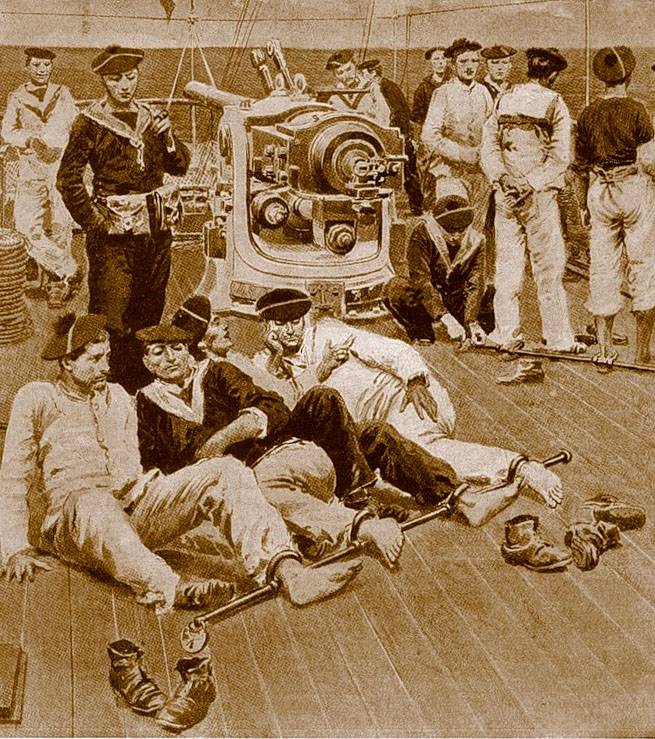
At the turn of the XIX-XX centuries in the French fleet practiced temporary chaining in shackles attached to a metal rod
In Russia, the system of punishments introduced by Peter I differed little from the ones that existed in England and Holland. The Russian military charter also provided for a wide variety of executions - for example, walking on wooden stakes, beating with batogs, gauntlets, branding with iron, cutting off ears, cutting off hands or fingers ... In the navy, killing was used, shackling in shackles and, of course, flogging - but not overseas "Cats", and domestic molt. The one who committed the murder was usually tied to the corpse of his victim, and with it he was drowned in the sea.
France was the first country to abandon cruel treatment of soldiers and sailors: there, during the 1791 revolution, all forms of corporal punishment were prohibited. Belgium made the same decision in 1830, Prussia, Italy and Switzerland in 1848, Austria-Hungary in 1868. In the US Navy, flogging continued until the 1880 of the year, in Britain - until the 1881. The latter list includes the Russian Empire, where corporal punishment was abolished only on 30 June 1904 of the year. From now on, the sailors were punished much more humanely: they were put under arrest, lost their cups or dismissals, were put on the deck "under the gun". However, the officially banned scuffle de facto remained in the fleet for a long time - both in our country and abroad.
In the Russian fleet for minor offenses, the lower ranks were often put "under the gun" - such as, for example, the four sailors of the battleship "John Chrysostom"
The system of disciplinary measures in the East was markedly different from the European. So, in the Chinese fleet, at the end of the 19th century, a punishment decree was adopted, adopted a half century ago for the land army. It is curious that in it corporal punishment was provided not only for lower ranks, but also for officers. For example, in September 1889, the commander of the gunboat, who put his ship on the rocks in the river Min, was subjected to one hundred blows with a bamboo stick.
Some articles of the Chinese Penal Code deserve to be quoted literally:
“Whoever doesn’t move forward on the drum beat or fails to retreat in a timely manner by a signal from Jung, he is to be decapitated.
Everyone who retreated without a team when meeting with the enemy, or who discovered fear, or raised a murmur, is subject to beheading.
Guilty of misappropriating the merits committed by others are punished by cutting off the head.
Anyone who asserts that in a dream he saw a devil and seduces with this omen of others is subject to the death penalty.
If a soldier falls ill during a hike, then officers must immediately examine him (the original is ba-tszun or qing-tszun) and take measures to heal, otherwise they are punished by sticking arrows into the ear; the soldier, pretending to be sick, cut off his head.
Guilty of arson are punished with 40 bamboo blows. Guilty of setting fire to gunpowder is punished by cutting off the head.
Guilty of oppressing the helpless and weak are punished with a whip and piercing with an arrowhead; the same punishment shall be imposed on the guilty of drunkenness.
Guilty of stealing military and other supplies or spoiling food bags are punished with 80 bamboo strikes.
Guilty of losing weapons Bamboo punished: 8-10 soldiers with blows; non-commissioned officers 40 blows; 30 officers blows.
A guard who falls asleep at the post is punished by 80 with blows of bamboo. ”
So: for the loss of weapons - eight strokes with a stick, and for the dreamed hell - the death penalty! How difficult it is for a European to understand the Eastern logic and the gradation of values there ...
In conclusion, it should be added that in China, beheading is considered a shameful death, and the execution by hanging is honorable.
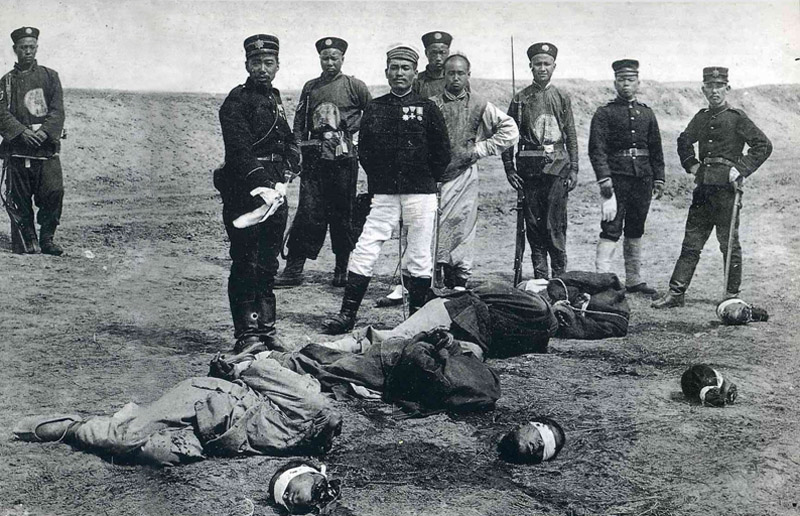
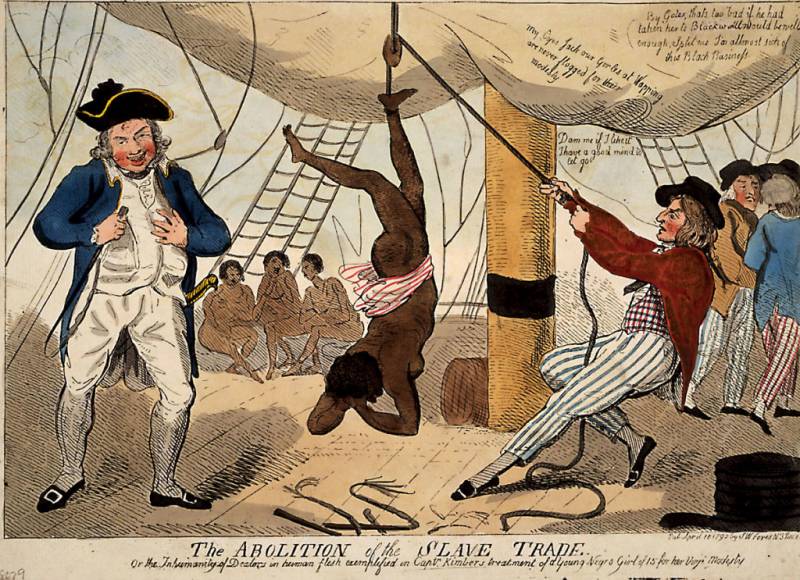
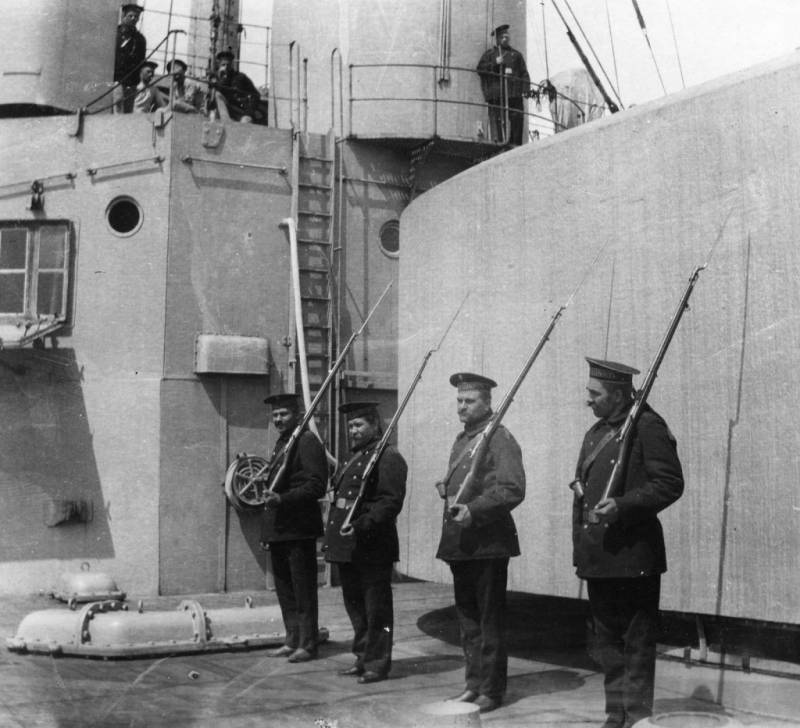
Information